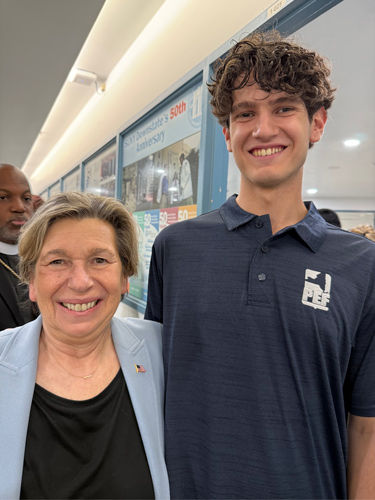July 18, 2025 — In 2020, when I was a sophomore in high school, the country was going through a uniquely challenging time. Covid caused the largest recession since 2009, and millions of American workers lost their jobs. Millions more were labeled “essential,” meaning they had to sacrifice their health and safety, often without any increase in pay.
Meanwhile, as people were dying and the poverty rate was growing, American billionaires gained more than one trillion dollars in wealth. As has been the case every year since President Ronald Reagan fired striking PATCO workers in an attempt to drive a stake through the heart of the American labor movement, the rich got richer at the expense of working people. It doesn’t have to be this way.
The Covid recession, and the spike in inequality that it brought, piqued my interest in the labor movement. I had long understood the importance of unions – my dad was a AFSCME steward when he was younger and made sure that my sister and I supported unions – but Covid transformed my vague support into a passion. By the time school opened back up – my junior year – I had spent hours studying the highs and lows of American labor, from the Haymarket Riot to the passage of the NLRA to the expansion of bargaining rights to public sector workers to the Janus decision that threatened those hard-won rights. In my research, a clear pattern emerged: stronger unions led to greater prosperity for the American people.
While applying for college, I learned about Cornell’s school for Industrial Labor Relations (ILR). It was perfect. At ILR, I have taken classes focused on labor history, labor law, and collective bargaining. In addition, ILR hosted a career fair where I learned about the PEF internship I am working this summer with the Field Services Department in New York City.

I have had the opportunity to meet with members who are fighting hard to ensure that they are treated with the respect and dignity they deserve. I attended labor-management meetings, witnessed interrogations, and celebrated a major investment into SUNY Downstate Medical Center that was achieved by the relentless advocacy of a coalition that included PEF. At that press conference in Brooklyn, I got the opportunity to meet AFT President Randi Weingarten, arguably the most powerful voice in this country’s organized labor movement.
Most importantly, I’ve learned the important technical details of writing grievances and understanding contracts. I’ve learned strategies for defending members when their rights are violated. All of these skills will help me help workers in the future, whether I am working at PEF or any other union.
Fundamentally, the mission of a union is to improve the lives of working people. A strong union – like PEF – does this by not only fighting for a good contract, but also by making sure that contract is enforced every day. Even as an intern I have been a part of that fight, and it fills me with immense joy and pride to be working on behalf of PEF members.
I urge anyone reading this, whether you are a PEF member, a non-member considering joining, or you’re not affiliated with PEF in any way, get involved with the labor movement. If you’re a student like me, apply for a PEF internship. If you’re already employed by New York State and a member of a PEF bargaining unit, run for steward or get involved with your division council. If you don’t have time for elective service, attend every membership meeting you can and take collective action when PEF urges you to do so. Whatever you can do to be an active PEF member, do it!
If I have learned one thing from working at PEF and from studying labor history, it is that unionism makes a better world possible. We must all do our part to create that better world.
Editor’s note: Aaron is a rising junior at Cornell’s ILR school. We thank him for all his hard work this summer and wish him the best as he continues his education. If you or someone you know is interested in an internship with PEF, please contact HR@pef.org. We have a variety of departments willing to take on interns and inspire the next generation of union leaders! In addition, you can find our current job openings, here.
